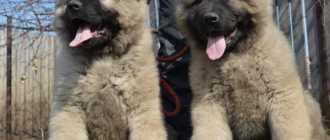History of the White Swiss Shepherd breed
Both Switzerland and America can be considered the homeland of the White Swiss Shepherd. Canada can also be added to these countries, since the development and formation of this breed also took place on its territory.
The direct ancestor of the Swiss White Shepherd is the German Shepherd. It is surprising that a pure white breed evolved from a dark-colored breed. Interestingly, crossing with other species was not carried out. Regarding the white color, it appeared thanks to a gene inherent in the German shepherd.
Despite the name, white shepherds were brought to Switzerland in the seventies. Before this, the breed developed in Europe, America, and Canada.
2003 brought this species official recognition as an independent breed from the FCI. Previously, white shepherds were registered as a subspecies of the German shepherd. Although in Switzerland this same recognition took place much earlier, in 1991.
The service qualities of the white shepherd are now used in law enforcement and rescue services. Also, smart and loyal dogs make excellent companions and pets.
History of the origin of the species
The direct ancestors of the White Swiss Shepherd (BSH) are German Shepherds. Initially, when this breed was created, all coat colors obtained as a result of selection were considered included in the emerging German Shepherd standard. But at the beginning of the 20th century, the practice of recognizing individuals with white coats as breed defects began to strengthen in the German canine community. Such specimens were excluded from breeding, which at some point led to a sharp reduction in the population and the almost extinction of the breed.
At the same time, several white dogs were introduced into the United States. On the American continent, they quickly gained great popularity and spread throughout the country, as well as in Canada. Cynologists of these two countries recognized the dog as an independent breed and named it the American-Canadian White Shepherd.
It was from here, in the 70s of the 20th century, that representatives of the breed were brought to Switzerland and registered in the Swiss Stud Book.
This is how the White Swiss Shepherd received its official name. It was from this moment that its active breeding began.
Dogs were exported from Switzerland to other European countries. Now the breed is very popular. At the same time, BShO fans in the USA, Canada and Holland prefer the short-haired type, while in the rest of the European Union countries long-haired white shepherd dogs are more common. The official BShO standard was published in 2011.
Breed standard
There is practically no difference between the white Swiss and German shepherds regarding the exterior. Only the coat color is not the same.
The weight of adults is 25-45 kg. , height about 53-65 cm .
The wedge-shaped head rests on a not too long, beautifully curved neck that has no dewlap. Strong, without skin folds, with chiseled lines. The skull is round in shape. The ears are rectangular in shape with slightly rounded tips, erect.
The muzzle is not too long. The eyes are almond-shaped, dark, not large, slightly slanted. The bridge of the nose is straight.
The jaws are powerful and have a scissor bite. The lips are not drooping, dense, black.
Croup with a slight slope towards the base of the tail. Not too wide, but long. The body is powerful. The back line is straight. The chest is oval in shape, not very voluminous. The stomach is slightly tucked.
The legs are straight, strong, sinewy, parallel, and not very long. Paws are oval shaped. The dewclaws must be amputated. The walk is a light trot. The movements are consistent and strong.
The tail is well furred, saber-shaped. Low set.
The skin is dry, without folds.
Regarding the coat, there are two types:
1. Short-haired – short, close-fitting hair. There is a thick undercoat. 2. Long-haired - hard, elongated hair. There is no undercoat.
The Swiss Shepherd's coat color is only white.
Maintenance and care
You can keep a Swiss Cattle Dog both in a house and in an enclosure. She is unpretentious, but requires a lot of attention from her owners. Representatives of the breed are very active; no matter how they are kept, they require daily walks and physical activity.
The Shepherd loves various active games. So take a ball or disc or frisbee with you for a walk. The dog will gladly support any fun.
Your Swiss Shepherd needs to be groomed regularly to maintain its health and appearance. Below are the necessary procedures that are important to carry out on time and in accordance with all the rules:
- Comb 1-2 times a week using a furminator. The White Swiss Shepherd sheds constantly, so regular grooming is important. Long-haired representatives of the species are first carefully combed with a comb with sparse teeth, unraveling the tangles. Then we take a comb with fine teeth, and finally you can use a massage brush.
- During the period of seasonal molting, we carry out combing daily. Veterinarians recommend buying a special spray for Swiss Shepherds designed for removing hair. It will greatly facilitate the care of the coat during intense shedding.
- We bathe when dirty. Frequent bathing is not recommended, as is excessive use of detergents. The fact is that the White Swiss Shepherd is predisposed to skin diseases and often has an allergic reaction to care products.
- After each walk, we wash and inspect the paws, and wipe the coat with a wet towel made of natural material.
- We trim the nails as they grow, although an active dog usually rubs them off on the road surface during walks.
- We wipe and examine the eyes and ears weekly. If there is a persistent accumulation of ear or eye discharge, you should take your dog to the veterinarian. The same should be done if you notice inflammation or redness.
The health of your pet depends on proper, balanced nutrition. The diet should contain a sufficient amount of minerals and vitamins.
If you choose an artificial feeding method, buy premium food. It contains all the necessary components.
The natural method of feeding has its own rules:
- We feed strictly at the same time, without leaving leftover food within the dog’s reach.
- Every day, a shepherd dog should receive at least 500 g of fresh lean meat.
- Porridge is required daily; legumes are prohibited.
- The menu includes: dairy products, vegetables, fruits.
- In the cold season we increase the portions.
It is important that your pet always has access to clean, cool water.
Pay attention to our article “What and how to properly feed your dog natural food“
Training at 3 months. Socialization
Three months is an important stage in introducing a White Swiss Shepherd puppy to the outside world. Your first walks should be short and not too tiring for the puppy. You should start with 15 minutes, gradually increasing the walking time to 1 hour.
Correct formation of the nervous system
At this age, the puppy’s nervous system is forming.
. It has been proven that raising puppies in isolation during this important period contributed to the development of pronounced cowardice in them later. It is necessary to show the puppy as much as possible: noisy streets, large crowds of people, etc. Everything that he will have to face in later life.
This must be done very carefully, gradually, over and over again increasing the time spent in noisy places, so as not to overload the puppy or frighten him.
The territory of a country house, cottage or village are places with a minimum amount of external stimuli for a city dog. Therefore, if you plan to keep a dog in an urban environment, “growing up” a White Swiss Shepherd puppy in such conditions depleted in irritants is unacceptable.
A city puppy must grow up in the city, in conditions that are saturated with external stimuli, such as: noisy streets, large crowds of people, other animals, birds, cyclists, cars, etc.
Meeting people and dogs
It is necessary to introduce the puppy to friendly dogs and people
so that later the puppy does not develop aggression or cowardice caused by the fear of new things and the inability to communicate and make new acquaintances. Currently, unfortunately, this is not uncommon in the behavior of adult dogs, but a fairly common problem with which people turn to our specialists for help.
Puppy behavior on the street
The emergence of new places leads to new rules that need to be consolidated:
- Now you can and should go to the toilet on the street, and not stoically endure it, carrying everything home;
- Not every new person or dog wants to communicate, so you don’t need to run headlong to meet everyone;
- Not all food is healthy, so it should only be taken from the owner’s hands.
Training and practicing commands
Training a puppy follows the same principles as at 2 months. It should be remembered that at this age puppies develop conditioned reflexes quite easily, but they are forgotten just as quickly, so you should not scold the puppy for not following commands, especially if they have not been repeated for a long time, but you should pay more attention to learning new things and repeating already covered material .
Health
On average, white shepherds can live 11-15 years.
Nature has awarded the shepherd with good health, but not everything depends on natural data. The owner must take care of the pet and monitor its condition. Only in this case can the dog live the maximum number of years.
The dog owner's responsibilities include:
- Annual visit to the veterinary clinic for preventive examinations.
- Deworming.
- Carrying out routine vaccination.
- Regular treatment with drugs against skin parasites.
Every dog owner should be aware of their pet's predisposition to certain diseases. Below are the diseases that are most often observed in white shepherds:
1. Dysplasia of the elbow and hip joints - characterized by pain and lameness in the initial stages, at the last stage the dog faces complete or partial immobility with unbearable pain. 2. Allergies – an allergic reaction to food most often occurs; there may also be an allergy to fleas and care products. 3. Congenital diseases of the spine are abnormalities in the development of the number or structure of vertebrae (scoliosis, lordosis, kyphosis).
4.
Autoimmune diseases are an attack of the immune system against the organs and tissues of the body’s own, resulting in their structural and functional damage. 5. Exocrine pancreatic insufficiency - can develop at any age, but more often in individuals under 4 years of age. 6. Osteoarthritis – leads to abnormal development of the hip joint, damage to the cruciate ligaments, knee dislocation and joint damage. 7. Von Willebrand disease is a hereditary blood disorder. 8. Cauda equina syndrome is a serious neurological disorder. 9. Degenerative myelopathy - caused by impaired conduction of motor neurons in the spinal cord.
Character
The American-Canadian White Shepherd is considered one of the most loyal, faithful and selfless dogs. She very quickly becomes attached to all family members, however, like other types of shepherd dogs (South Russian, Groennendael, etc.).
The Swiss Cattle Dog has a good-natured disposition; it always strives to be close to its owner and spend as much time with him as possible, but is not interested in comfort.
In the forest, in the forest, in the rain, in the rain, just to be with my family. At the same time, you can’t call her annoying.
The White Swiss Shepherd has a sharp mind and is inquisitive. Her character is balanced and level-headed. Such a pet will come to the rescue at any moment, at the first call, and will never betray. It is believed that representatives of the breed are ideal companions.
They do not show causeless aggression towards strangers. The White Shepherd is wary of strangers and watches them. Aggression occurs only if a stranger has given reason to doubt his good intentions.
Treats children well. Seeks to take custody of them. Enjoys taking part in games. In a dangerous situation, a white Swiss shepherd will be able to defend a child.
Gets along well with other pets. There may be competition between male dogs for leadership. It is recommended to introduce the puppy to the outside world from a young age. Having undergone early socialization, the dog will grow up to be adequate in relation to strangers and animals.
Character and temperament
The temperament of the Swiss Shepherd is almost ideal, as evidenced by reviews from owners of dogs of this breed and experienced dog handlers. The dogs are excellent at learning commands and have a cheerful, calm character. The pet is a reliable, vigilant guard who gets along well with other animals. A good-natured dog demonstrates quick wit and a sharp mind: the Swiss are always on the alert, especially when surrounded by strangers, while the dog behaves calmly and does not show aggression unless necessary.
Albinos belong to the category of family dogs; they easily find an approach to each family member. It is worth understanding, however, that the Swiss Shepherd is a selfish dog and does not tolerate disrespectful treatment. The dog's friendly disposition is combined with the traits of an ideal service dog: when the animal feels threatened, it speaks loudly. Pets can also bark when expressing joy. A developed mind does not allow albinos to spoil home furnishings, so a shepherd dog will not cause trouble for its owners.
- Stencil hair coloring
- These 2 Vitamins Can Change Your Life After 60
- 15 things you do every day that really annoy other people
Training and education
The Swiss Cattle Dog is extremely hardworking, disciplined and responsible. She has an excellent memory, she learns quickly, remembering commands almost the first time. The obedience of a shepherd is at the highest level, subject to proper upbringing and training.
The basics of training take place at an early age, up to 5-6 months, at which time the puppy masters basic commands. A six-month-old pet can already be trained at a more serious level. A young shepherd dog at the age of 1 year is ready to undergo a special training course.
It is recommended to master complex specialized skills (protection, assistance to people with disabilities, etc.) with the help of a specialist at a special training site.
Interesting Facts
- The first officially registered German Shepherd with a regular coat color had a great-grandfather with a pure white coat.
- The Swiss Cattle Dog was valued by farmers because it blended in with the white wool of the sheep, without standing out in the flock that was under its protection.
- For a long time, they did not want to recognize this breed as a separate species. All because of the erroneous belief that white coat color negatively affects the performance of dogs.
Training from 6 months
At this age, the puppy begins puberty and the real rebel awakens in him. He begins to re-test the boundaries of what is permitted and, sometimes, deliberately does not respond to your commands, only in order to look at your reaction. If she is not what the puppy expects to see, then he may decide that now he can no longer carry out your commands.
Remember that a puppy is still a child.
, and excessive harshness can forever undermine his trust in you.
At this stage of a White Swiss Shepherd puppy's growing up in training, all the shortcomings made at the previous stages, which were smoothed out by his young age, become clearly visible. And if they appear, it’s time to correct them.
In many training schools, there is an opinion that a puppy needs to be trained in two stages, the first at an early age, and the second at 8 - 10 months, in order to “consolidate” what has been learned. This is not an entirely correct position; this opinion appeared when newer operant training methods began to be added to the old “DOSAAF” rigid training methods, where they began to work with the puppy strictly after 6-7 months, including working with the method of pointing and following the “target”.
Their weakness was that they were two different techniques.
, which began to be used without adapting to each other, having a huge gap between their tools for developing training skills. The difference between them is like between choreography lessons in kindergarten and army drill training. Therefore, they required training in two stages, which were in no way connected with each other.
Modern methods based on zoopsychology make it possible to train a puppy in a single system , when no additional stages of training are required.
Pros and cons of the White Swiss Shepherd breed
The White Shepherd is suitable for people who like to spend their free time moving and being active. Below are the main advantages and disadvantages of this breed. Once you get acquainted with them, you will be able to understand whether this breed is suitable for you or not.
Pros:
1. Beautiful exterior. 2. Devotion. 3. Lack of excessive aggression. 4. Good attitude towards children. 5. Very trainable. 6. Efficiency, endurance. 7. Excellent security and watchdog qualities.











